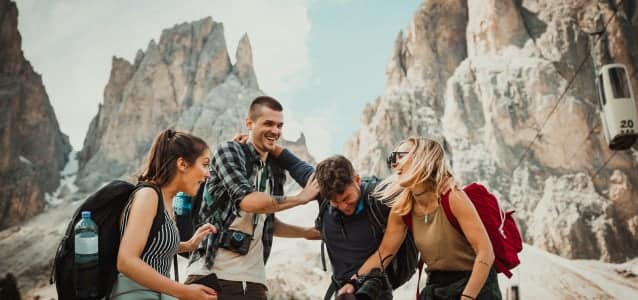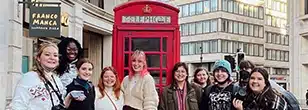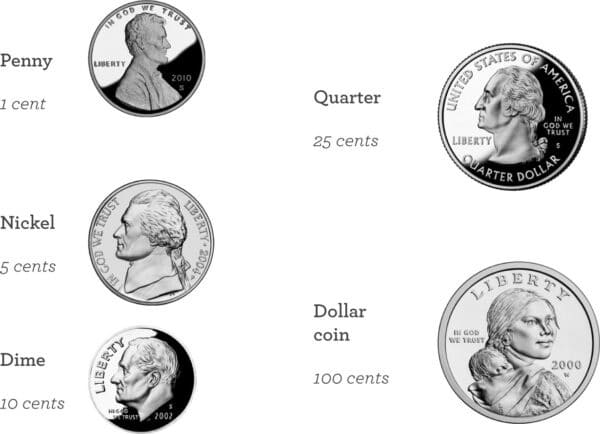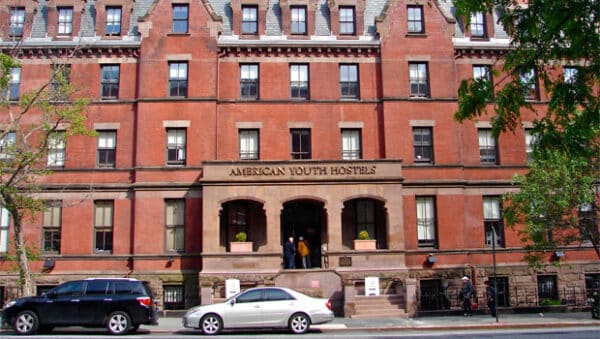Inside the USA
Inside the USA provides useful advice and guidance for your stay in the United States. Some of the information, such as recognizing culture shock, will help you during the early days of your program, while other information, such as budget accommodations in the U.S., may be more useful during the later stages of your program.
Refer to this guide throughout your program for helpful tips and contact information.
Quick Links
Pre-Departure Information
Improve Your English Language Skills
A vital part of your cultural exchange experience is being able to interact with and talk to people in the U.S. Speaking English will be the most important tool for you to be able to fully engage and learn about American customs and practices. It is a good idea to practice English as much as possible before you arrive in the U.S., as it will help you adapt more quickly.
- Take an English language course before the start of your program or find a native English conversation partner.
- Watch English language television or movies; listen to English language radio broadcasts; read English language newspapers, books or magazines.
- Practice, practice, practice! Speak English as often as possible and don’t be afraid to make mistakes. Most native English speakers will be happy to help you choose the right words.
Research Your Host Community
Review the state-by-state guides we provide on the Cultural Compass section of our website. You’ll find popular options for experiencing American culture in the state you’ll be visiting.
Airline Baggage Allowance
Be sure to check with your airline on how many pieces of luggage you may bring, the size, and weight of those pieces and the cost per bag. Please be aware that many airlines in the U.S. have started to charge for luggage on domestic flights. Contact your airline before you depart to find out the latest fees and restrictions.
What to Bring With You (do not overpack!)
- Your passport, J-1 Visa and DS-2019 Form: You cannot get into the United States without these items, so make sure you have them in a carry-on bag. Make a copy of each of these documents and keep them in a separate bag, just in case you lose the originals.
- Dictionary: A good bilingual dictionary is essential.
- Pictures: Photographs of your family, friends and your hometown to show new friends.
- Items from your home country: Pictures, arts & crafts, recipes or small, locally made gifts are always nice to share with people in the United States.
- Toiletries: Shampoo, soap, a toothbrush, toothpaste, a razor and deodorant are essential. You can buy a supply for the duration of your program once you arrive in the U.S., so just bring enough for one week. Liquids in your carry-on luggage must be in 3 ounce (88 ml) bottles. If you bring an electric razor, make sure it is battery powered, because adapters tend to fail.
- Medications (pack in your carry-on luggage): If possible, you should bring enough medication for the entire time you are in the U.S. and use the original bottle. Also, bring a note (written in English) from your doctor, indicating the type of medicine you take, just in case you need to get more. We recommend that you call your airline first to check what type of medication and how much you are allowed to carry on the airplane.
- An extra pair of prescription glasses: This will be very important in the event that your glasses are damaged or if you cannot have your contact lens prescription filled while in the U.S.
- Driver’s license: Bring your international driver’s license and/or foreign driver’s license with you and be sure to pack it in your carry-on luggage. Keep a copy in a safe place.
- An open mind: Be prepared for things to be different.
What to Leave at Home
- Valuables: Expensive jewelry and family heirlooms.
- Anything you might be afraid to lose or that might get stolen.
U.S. Culture & Culture Shock
U.S. Culture
The United States is called a “melting pot”: a place where people from countries all over the world come to build their lives and homes. The U.S. is home to people from all different cultures and nationalities. Each group has its own background, customs and values, which form what we call American culture. It is a culture that is continually being reshaped and redefined as more people from other countries immigrate to the U.S., but it is also influenced by the visitors who share information about their cultures when they interact with people who live in this country.
One of the best opportunities you will have over the course of your time in the United States is to learn more about American culture. That’s what cultural exchange is all about. You will discover new things about Americans every day, and as a result you may decide to change some of your behaviors in order to adapt. Remember that adaptation is part of the fun of experiencing a new culture. It is not always easy, but remember that you are temporarily in the United States for a new learning experience; you will be returning to your familiar lifestyle afterward, so it’s important to be flexible about making changes to how you do things. The key to a successful program is to stay positive and explore all the opportunities given to you.
Part of the excitement of living in a new culture is learning about how it differs from your own culture. You might compare your values and customs with the new values and customs you observe every day. The American way of life may be very different from your own, and that difference is part of your cultural exchange experience. Your time in the U.S. is designed to be a great learning opportunity, so take advantage of it!
We’ve also created a list of recommended sites and activities for you to enjoy while you’re in the U.S. Take a look and discover new places and aspects of American culture.
Characteristics of U.S. Culture
Keep in mind that the following characteristics are generalizations, and as with any country or culture, there are many exceptions and lifestyles that may be quite different.
- Being on time is important.
- Americans like their privacy and their own space.
- Americans can be very direct and honest and might appear rude to people from other cultures.
- Americans are polite and say “please” and “thank you” a lot.
- Americans wait their turn. Everyone is expected to stand in an orderly line (queue), without pushing to be first.
- Americans may not know much about your country or other cultures.
- Americans value independent thinking.
- The role of the mother and father in an American family is more or less equal regarding child care and household responsibilities.
- There is an emphasis on education and learning for everyone.
- Americans like to joke, smile and talk. They will try to fill up quiet time with “small talk” about the weather and sports. They like direct eye contact, but they don’t like to stand too close to one another or be touched while talking.
- Nudity is usually not accepted in the home and definitely not in public.
- Americans are very concerned about personal hygiene and cleanliness; it is not unusual to take one or even two showers a day, and almost everyone uses deodorant.
- American family life and child-rearing practices are extremely child centered. Children in the United States are encouraged from an early age to express themselves, take responsibility for their actions and help in the house. Parents believe such an upbringing will help children develop confidence and self-esteem.
- Very few Americans employ household staff. Even guests are expected to make their own beds and offer to help with chores.
Signs of Culture Shock
Culture shock is described as the anxiety, feelings of frustration, alienation and anger that may occur when a person is placed in a new culture. Many of the customs here may seem odd or uncomfortably different from those of your home country. Being in a new and unfamiliar place can be challenging even for the experienced traveler, and some feelings of isolation and frustration are totally normal. Participants experience culture shock to varying degrees; some hardly notice it at all, while others can find it very difficult to adapt to their new environment. Many may not attribute their problems to culture shock. Whatever the case may be, understanding these issues and why they happen will help you.
Some common symptoms of culture shock are:
- You may feel isolated and frustrated.
- You may become nervous and/or excessively tired.
- You may sleep a lot, even after you have recovered from jet lag.
- You may be excessively homesick. It is normal to miss home, family and friends. But if you can think of nothing else, write or call home all the time and perhaps cry a lot, you are probably suffering from culture shock.
- Due to your discomfort, you may feel resentment toward your new environment or the people around you.
- You may become dependent upon other participants from your home country. These friendships are important and are extremely supportive. However, if you spend time exclusively with people from your home country, you will miss the experience of interacting with people from the U.S. and other countries. InterExchange separates participants from the same country as often as possible so that they can more fully immerse themselves in English language and U.S. culture and traditions.
- You may be anxious about your job: “Why does my employer speak so loudly and quickly?” or “Will I be able to repay my parents the money they lent me?” This stress can become overwhelming and cause tension.
- You may feel reluctant to speak English or associate with people.
How to Cope With Culture Shock
- Maintain your perspective.
- Keep an open mind and a sense of humor. People in the U.S. may do or say things people in your home country would not. In order to overcome culture shock you must accept certain aspects of the new culture.
- Talk to people about how you are feeling. You are not alone and do not have to go through the adjustment by yourself.
- Stay positive! Remember the time before you came to the U.S., and remind yourself why you wanted to participate in the program.
- Talk with your friends and your employer. They will be understanding and supportive.
- Speak English.
- Make friends with people from other countries.
Take Care of Yourself
Like all rewarding experiences, being a participant in a cultural exchange program is sometimes difficult. Staying healthy and dealing with your stress will help to make your time abroad more fun, and improve your interactions in the workplace. Use these tips to make your days easier:
- Relax when you feel stressed. Try breathing exercises, yoga or imagine places that make you happy.
- Keep a journal. This will help you to enjoy the wonderful days, and to get through the more difficult days.
- Communicate often with your employer. If you are feeling frustrated, see what you can change about the situation.
- Talk with other participants. You can support and encourage each other.
- If you have had a hard day, spend some quiet time without television or other distractions. Listen to music. Take a shower. Read a book. Exercise. Take a walk.
- Get plenty of sleep. If you are tired, you are more likely to get frustrated and sick.
- Eat a healthy diet, drink plenty of water and exercise regularly so that you have the energy needed to make the most of each day.
- Take vitamins to stay healthy.
- Wash your hands often. This will help you avoid getting sick.
- When you do get sick, be careful with cold medicine. Many cold medicines will make you very sleepy, which will make your work more difficult. Make sure any medicine you take while you are working is “non-drowsy.” This means it will not make you sleepy.
- Think about the things you enjoy about the U.S. or plans you’ve made to travel during your 30-day grace period.
Important Note for Non-Native English Speakers
You should always try to speak in English during your program. You may be uncomfortable with your skills and even feel embarrassed, but you will quickly notice that people will correct your mistakes in a positive way. Your English abilities will improve through your mistakes. Everyone will appreciate your willingness and desire to improve.
The worst mistake you can make is to keep silent. If you don’t speak, your employer may think you are incapable of performing your job. You must be able to communicate. Practice and repetition are the only ways you will improve your English skills.
If you don’t speak English and only speak in your native tongue, it will be harder to get to know people who cannot speak your native language. Because English is being spoken by everyone around you, speaking English will enable you to make friends with people from many cultures. These friendships are some of the most rewarding elements of the program.
InterExchange Participant Rights, Protections, Understanding
InterExchange makes it a priority to ensure that all our participants enjoy a safe, healthy and well monitored cultural exchange experience in the U.S.
The following information describes a baseline for conduct that our participants can expect from InterExchange and their hosts as well as their responsibilities during their visits to the United States through InterExchange programs. We’re happy to say that the majority of our participants and hosts regularly make an extra effort beyond these standards to create a truly memorable, life-changing cultural exchange experience for everyone involved.
During Their Programs, InterExchange Participants Can Expect:
- A safe, healthy and legal work environment.
- A safe, healthy and legal living situation.
- Opportunities to interact with Americans on a regular basis.
- Protection of their legal rights under United States immigrant, labor, and employment laws.
- Fair treatment and payment practices.
- Right to keep passport and other documents in their possession.
- Right to report abuse without retaliation.
- Right to contact the J-1 Visa Emergency Helpline of the U.S. Department of State.
- Right not to be held in a job against their will.
- Right to end their programs and return to their home countries.
- Right to request help from unions, labor rights groups and other groups.
- Right to seek justice in U.S. courts if warranted.
Participants Can Also Expect the Following Support From InterExchange Throughout Their Programs:
- Emergency assistance 24 hours every day.
- Serving as a reliable resource for general information.
- Resources and guidance to help them engage in cultural learning and American daily life.
- At a minimum, monthly contact and monitoring.
- Vetting and conducting due diligence to verify each host employer or host family.
- Available staff with extensive international experience and language skills.
- Available staff who can provide support for special situations if needed.
- Acting as a neutral advocate to help resolve any disputes that occur.
- Accident and Sickness insurance that meets or exceeds J-1 Visa regulatory requirements.
Participants in Our Programs Acknowledge That:
- The primary purpose of InterExchange cultural exchange programs is to interact with U.S. citizens, practice the English language, travel and experience U.S. culture while sharing their culture with Americans.
- They will abide by the laws of the United States.
- They will abide by all rules and regulations applicable to U.S. Department of State Exchange Visitor programs.
- They have not come on a J-1 Visa program seeking permanent residency or employment in the U.S.
- They are expected to follow the guidelines of employment provided by their host employer or host family.
- InterExchange is their visa sponsor. A U.S. host employer or host family is not a visa sponsor.
- Any wages earned during the programs are only meant to help defray living expenses during the programs. Earning money is not the primary purpose of cultural exchange programs.
- Host employers and families may terminate their employment relationship with participants.
- Host employers and families do not have the authority to cancel the J-1 Visa. Only the U.S. Government or InterExchange has that authority.
- They must contact InterExchange in the event of an emergency or if any problems occur during the program.
- They will respond to all requests and inquiries sent from InterExchange.
- They are required to leave the United States at the end of their programs.
More Resources
Rights and Protections for Temporary Workers
U.S. Department of State
Types of Discrimination – Harassment
U.S. Equal Employment Opportunity Commission
Civil Rights Center – Workplace Harassment
U.S. Department of Labor
Natural Disaster and Emergency Evacuation
Your safety is our priority. In the event of a natural disaster such as a hurricane, flood or other extreme weather or emergency situation, it is mandatory that you comply with emergency procedures and follow instructions issued by InterExchange and your local Office of Emergency Management.
For the most current information on evacuation notices and to learn what your local area is doing to prepare for an extreme weather event or emergency, visit the website of your local Office of Emergency Management. They can also provide information about maintaining an emergency kit for such situations. Talk to your host employer to get information and guidance on how to prepare for an emergency as well.
After major emergencies in the U.S., InterExchange will reach out to confirm that you are safe and to verify whether you have evacuated. Please respond promptly so that we know you are safe. And as always, please reach out to us if you need help during an emergency.
Important Information If You Are Evacuated
It is required that you follow local evacuation instructions in emergency situations. Should you be evacuated, make sure to take important documents with you. This includes your passport, DS-2019 Form, Social Security Card, financial records, plane ticket, checks, credit cards, etc.
Take important contact numbers and email addresses, and make note of the InterExchange emergency: 917.373.0994.
Contact your family members to let them know you are safe and how you can be reached, and let InterExchange know immediately where you have relocated.
Money in the U.S.
You will probably earn enough money to buy souvenirs, go out in your free time, travel after the program is over, and even save some money. At the very least, you should be able to save enough money to get back to New York (or your departure city) in order to fly home at the end of the program.
You should prepare to have a few different ways to access money while in the United States, such as traveler’s checks, an ATM card or a credit card. Handling your money in these ways is safer than carrying around large amounts of cash.
Paper Currency
American paper money comes in a standard size and all denominations are green in color. The difference in the bills is the famous face on the bill and the number in the corner. Bills are available in $1, $5, $10, $20, $50 and $100 denominations.
George Washington= $1.00
Thomas Jefferson= $2.00
Abraham Lincoln= $5.00
Alexander Hamilton= $10.00
Andrew Jackson= $20.00
Ulysses Grant= $50.00
Benjamin Franklin= $100.00.
A note on large bills and slang: Be aware that many places will not accept hundred dollar bills and some will not accept fifty dollar bills, like a late night or all-night gas station or convenience store or coffee shop. Be sure to have some twenties or smaller denominations on hand and don’t expect that a fifty or a hundred dollar note will be accepted everywhere. A dollar is often called a “buck”, ” which will cost 20 bucks”.
Coin Currency
Coins come in different denominations and each denomination is a different size. One dollar is equivalent to 100 cents. Americans use the following coins:
Traveler’s Checks and Travel Cards
Carry a mix of cash and cards. We recommend that you bring traveler’s checks or prepaid Visa or Mastercard with you in U.S. dollars. The prepaid cards give you easy access to funds that are safely stored on the card and are acceptable anywhere Visa and Mastercard debit cards are accepted. Beware of any fees associated with the prepaid card. Because of ATMs, traveler’s checks are becoming obsolete except as a trustworthy backup. Whilst years ago cashing a traveller’s check may have been no trouble at any location with proper photo identification, this is progressively changing. Some businesses may require a spend requirement for cashing the check . If they get stolen or lost, you can have them replaced, but only if you have the record of the numbers. Make sure you keep the receipts separate from the checks. Contact the company that issued the traveler’s checks or cards immediately if they get lost or stolen!
Some issuers of Traveler’s Checks and Traveler’s cards in the U.S.:
American Express
Phone: 1-800-221-7282
Travelers Cheque resourceMasterCard
Phone: 1.800.627.8372
Prepaid Travel Card
Banks
U.S. banks are mostly regional, so you won’t necessarily find the same bank everywhere in the country. Banks are usually open from 9:00 a.m. – 5:00 p.m., Monday to Friday, but many are open on Saturdays. If you open an account in the U.S., try to find a bank with many locations, so you will be able to withdraw money and cash paychecks without incurring fees. You can research branch locations and ATM locations by checking the bank’s website. Your employer may also be able to suggest a convenient bank.
Bank Machines
Automatic Teller Machines — ATMs
ATMs are almost everywhere and they work the same way they do in your home country; they will allow you to get cash from your bank account as well as perform deposits and other transactions. Your bank card from home is likely to work in ATMs in the United States, but you should check with your home bank just to be certain. Remember, you will probably be charged a small fee to use an ATM outside of your home country. Many ATMs charge a fee to withdraw money; your bank at home may also charge an additional exchange fee.
Bank Account Tips and Security
Always know how much money you have in your account to avoid overdraft fees. Learn about opening a bank account.
Protect Your Privacy
- Never share your ATM card or password, and be sure to check your account statements frequently for unauthorized charges. Cards in the U.S. must have magnetic strips on them.
- Never accept money or money transfers from strangers.
- Be aware of people and your surroundings when using an ATM.
Credit Cards
Credit cards are accepted almost everywhere, but be careful! International transaction fees when you withdraw cash can be quite high. To report a lost or stolen credit card call:
- American Express: 1.800.297.8500
- MasterCard: 1.800.627.8372
- VISA: 1.800.847.2911
Sending Money Home
Every year participants on our programs work hard, save as much money as possible and then wonder how they can get it home safely. Over the years, InterExchange has heard many sad stories about participants who carried their earnings in cash and had it all stolen before they reached home. Never carry large amounts of cash. Do not carry your savings in cash! We want to make sure that you hold onto your hard-earned savings.
If you have a bank account in your home country, you should be able to transfer money to it fairly easily, especially if it is a U.S. dollar account. The transfer usually costs you approximately $30 and may take 3-4 weeks to appear in your account at home. In most countries your bank will charge between 0.5-1.0% of the total sum to withdraw cash from the account. Please consult directly with the bank regarding international money transfers and associated fees.
Alternatively, you may find it convenient to buy traveler’s checks. It is a safe way to carry money. You can use what you need as you travel and changing them back into cash at home is relatively easy. There are some fees involved in converting traveler’s checks to cash in your home country. In some places it is as low as 1%.
International postal money orders may also be a good option for some participants. The fee varies depending on the destination country and is usually between $3 and $8.50 per money order. Each money order can be a maximum of $700 and there is no limit to how many can be sent in a given time period. International postal money orders are generally issued in U.S. dollars and then converted into local currency at the time they are cashed according to the current exchange rate. Most large post offices should be able to offer this service.
If you open a U.S. bank account during your program, it is also possible to leave it open and use your ATM card to withdraw money as you travel as well as after you return home. Most ATM cards can now be used internationally. There may be ATM fees that vary from country to country but this still may be a good option for you. It is also easy for you to close your account by mail after returning home.
It may not be possible to cash an out-of-state check in New York City or your home country, so please make arrangements with your employer to receive your last paycheck before you leave the state in which you worked. Checks have an expiration date, so be sure to cash or deposit your paychecks before they expire. If your employer pays you through direct deposit, make sure you leave your American bank account open until after you have received your last paycheck.
The best-known companies for sending money are Western Union and MoneyGram. Both charge variable fees depending on how much money you’re sending and where you’re sending it.
U.S. Correspondence
DS-160 Form
U.S. Mail
Visit usps.com for the most up-to-date information on pricing.
Domestic mail weighing less than one ounce requires a 49-cent stamp ($0.49). Postage for other items varies depending on size, weight and—in the case of international mail—destination. Postal service prices are subject to regular changes. To find out updated prices, contact your local post office or visit the U.S. Postal Service on the Internet at postcalc.usps.com.
The U.S. Post Office can also send packages, by air or surface transport. If you need something to be delivered quickly and need to track it, then the courier services FedEx or UPS are usually better options. Both offer domestic overnight and 2 to 5 day service worldwide. The faster you want your package to arrive, the more it will cost! U.S. mail is delivered Monday through Saturday, except national holidays.
The DS-2019 Form
The DS-2019 Form is your proof of sponsorship. This form allows you to legally work in the United States (provided you also have a valid J-1 Visa) for a specified period. It is also the form that determines how long you can work and stay in the U.S.
Note: Halfway down your DS-2019 Form, you will find a section labeled “3.” Two dates will be printed in this section. These are the dates that you may begin and end your work commitment in the U.S. You are allowed to travel in the United States for 30 days beyond the end date listed in this section. Please check these dates and all other personal information thoroughly and let us know immediately if you have any questions or concerns or if there are any mistakes. You are eligible to work only with a valid DS-2019 Form and only between the dates listed in Section 3 of the DS-2019 Form.
The SEVIS Receipt - I-901 Form
You will need your SEVIS Receipt (I-901 Form) to apply for your J-1 Visa. The U.S. Department of Homeland Security requires all applicants to pay this fee before the Department of State issues them a visa. This SEVIS fee is included in your InterExchange program fees, and we will send you your SEVIS Receipt in the same shipment that we send your DS-2019 form.
After you receive your visa, in most cases, you will not be asked to show your SEVIS fee receipt at the border. We recommend carrying your receipt with you in case the inspector has questions at your port of entry.
If you’ve lost your SEVIS receipt, print a new one here.
J-1 Visa
When you get your passport back from the embassy, hopefully, you will have received your J-1 Visa! The visa is the document that allows you to enter the United States and explains why you are in the country. The J-1 Visa is an Exchange Visitor Visa sponsored by InterExchange. InterExchange is your sponsor for visiting the U.S. No one except InterExchange, or a U.S. government agency has the authority to cancel your visa.
There are two items on the J-1 Visa that you should check:
- Entries. Under this heading, there will either be the number “1” or the letter “M.” If your visa has the number “1,” it is a Single Entry Visa. This means you can only enter the United States one time. Once you have entered the U.S., you may not exit and re-enter the country again for the duration of the program. If your visa has the letter “M,” it is a Multiple Entry Visa and it allows you to enter the U.S. several times. You could, for example, go to Canada during a weekend off and re-enter the United States. You should not plan on leaving and re-entering the United States during the 30-day travel period.Important: If you have an “M” Multiple Entry visa and plan to travel outside the U.S. and return, you must re-enter the U.S. before the expiration date on your visa and have your DS-2019 Form signed by InterExchange. Please note that, depending on your home country, you may be required to obtain a visa to travel to Mexico or Canada. Please contact the Mexican or Canadian consulate for information.
- The expiration date. You are only allowed to enter the U.S. until the expiration date stamped on your J-1 Visa (even if it is multiple entry) or until the end date of your DS-2019 Form, whichever is earlier.
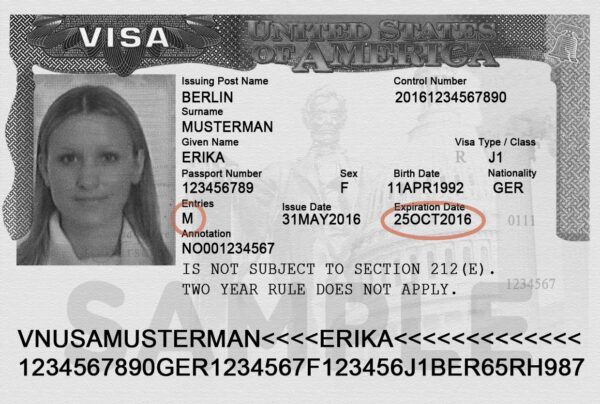
- M = Multiple entries up to expiration date. If “1” is indicated, you may enter the U.S. only once.
- Expiration Date = Last date of eligibility to enter the U.S., as long as accompanied by a valid DS-2019 Form.
The J-1 Visa (along with your DS-2019 Form) allows you to:
- Work up to 4 months or from the beginning date to the end date listed in Section #3 of your DS-2019 Form
- Obtain a Social Security Number
The J-1 Visa for the Camp program does not allow you to:
- Work as a domestic caregiver (for example, as an au pair), in the medical field, or in any other form of paid worker occupation
- Work for any employer other than the camp at which you were placed or obtain a second job
- Extend your work eligibility
Remember: The J-1 Visa on its own does not give you the right to work or stay in the U.S. The J-1 Visa is only valid with the appropriate DS-2019 Form.
Important Notes
You must return home within 30 days of your last day of work. InterExchange Camp USA will report all participants who do not return home to the U.S. Department of State and to their home countries’ embassies.
J-1 Visas issued by U.S. Embassies in some countries may have an expiration date that is later than the end date of this program. For example, you may find that the embassy has given you a visa that expires in two years instead of four months. This does not allow you to stay in the U.S. for longer than the duration of our Camp USA program, which is indicated on your DS-2019 Form. Instead, it means that if you want to return to camp next year, you may not have to apply to the U.S. Embassy/Consulate for a new J-1 Visa. However, you will still need to get a new DS-2019 Form. The J-1 Visa is not valid without a DS-2019 Form. Some countries also have early end dates. Please be sure you know when you need to return to your country.
I-94 Arrival and Departure Procedure
The U.S. Customs and Border Protection (CBP) will document your arrival upon entry to the United States by sea or plane through your electronic I-94 record (DHS Arrival/Departure Record). Participants arriving by car (most common with Canadian or Mexican participants) will still be given a paper copy of this document.
To record your entry in the U.S. the Immigration official will stamp your passport. The admission stamp will have information about your date of entry, visa type, and duration of your stay (D/S) in the U.S. The immigration official may stamp your DS-2019 Form as well.
The U.S. Customs and Border Protection (CBP) will make your electronic I-94 record available.
We recommend you access and print your electronic I-94 record by entering the information below. It is located on your J-1 Visa stamp. You should keep this printed copy with you when applying for important documents like your Social Security Number or other forms of identification in the U.S.
- Passport number
- Date of birth
- Full name
- Country of origin
- Date of entry in the U.S.
- Class of admission (your visa type)
If you cannot access your I-94 record online, you may need to wait a few more days for the CBP to process your arrival information. If this occurs, please check back periodically and reference the How to Use the Website and Questions/Complaints section on the website, or contact the CBP office directly.
If the information on your I-94 record is incorrect, please visit a local CBP Deferred Inspection Site or port of entry. Locate the closest CBP Deferred Inspection Site.
The CBP will record your departure from the U.S. using information gathered at the time of your arrival into the U.S.; you do not need to present your printed I-94 record when leaving the U.S.
The Telephone System in the U.S.
How to Make a Call
There are four types of calls you may need to make while in the U.S.: local, long-distance, toll-free, and international.
We will use the InterExchange telephone number, 1.212.924.0446, to demonstrate how to use the phone system in America. Phone numbers in the U.S. consist of a 3-digit area code (e.g. 212), then a 7-digit local number (e.g. 924.0446).
Local, Regional and Long Distance Calls
If you call a number within or outside of your area, you will usually need to dial 1 plus the area code (e.g. 212) and then the 7-digit local number (e.g. 924.0446). Some small towns with only one area code may only require you to dial the 7-digit local number. Ask your host or dial “0” for help from an operator. A cell phone will automatically add 1 to the beginning of any long distance call.
Free Phone Numbers (Toll-Free)
There are several different prefixes for toll-free numbers: 800, 888, 877. To dial a free phone number, simply dial 1 plus the 3-digit prefix, plus the 7-digit phone number. (Note: pay phones in some places, such as airports, may charge 25 cents for a toll-free call.)
Numbers that start with 900 are premium rate calls that can be very expensive.
International Calls
When making international calls you must dial “011” followed by the country code, city code (you must drop the “0” before the city code) and number. These calls tend to be expensive, so you should not use your employer’s telephone without his or her permission. It is much cheaper to use a phone card such as those provided by eKit (pay as you go). Most phone cards designed for international use will have better rates than your employer’s telephone plan. To find out the country code for your country, visit www.countrycallingcodes.com
Emergency Phone Number – 911
Wherever you are in the U.S., you can dial 911 on any telephone in an emergency. You will be connected to emergency services (fire department, police and ambulance). This is always a free call. Do not call 911 for non-emergencies!
Coin-Operated Public Telephones
Coin-operated public telephones are not as common in the U.S. as the once were. If you do find one, most local calls cost around 50 cents on a public pay phone. The U.S. does not have phones where you can insert a phone card. Each pay phone will have directions printed on it. If you are calling outside your local area, dial the phone number and then a recorded message will tell you how much money you will need to insert into the phone. You should have several dollars worth of coins ready if you are making a long distance or an international call on a pay phone.
Phone Cards
You can use a phone card when using a public pay phone or someone’s private phone. However, unlike in most other countries, phone cards in the U.S. are not inserted into the telephone. Phone cards have a toll free number, 1.800 plus 7-digits, which you dial first. Follow the instructions printed directly on the phone card to make a call.
Collect Calls
Calling “collect” means that the person making the call does not pay for the call, but the person receiving the call does. Please be sure that the recipient of your call has told you it is okay for you to call them collect. Otherwise you should call them using a phone card. Collect calls cost more than dialing normally.
Directory Assistance
If you do not know a telephone number, you can call 411 for information (you will be charged a fee). You will need to tell the operator which city you are calling and the name of the person or business you are trying to reach. Directory assistance for toll-free numbers is 1.800.555.1212. Use this number when inquiring about phone numbers for airlines and bus companies.
Letters in a Phone Number
Phone numbers in the U.S. may contain letters, especially free phone numbers. When you look at the phone pad you will see that each number corresponds to 3 letters. Simply press the number where the letter appears; for example, 1.800.AUPAIRS would be 1.800.287.2477.
SIM Cards
SIM cards are offered for purchase in many retail stores. These cards can be inserted into unrestricted international mobile phones for use in the United States. It is important to be aware of the charges associated with any SIM card before purchasing it!
Roaming: When you use your mobile phone while traveling to a different country it is called roaming. These roaming fees are excessive so make sure you are aware of the rates before using your mobile phone from your country. The only answer to excessive roaming fees is to use a phone service from the USA. Make sure your phone is unlocked and get a local SIM and calling plan.
Skype
If you’ve brought along a laptop, tablet, smartphone or have access to a computer and have access to the internet, you can use Skype to make cheap or free international calls. Visit www.skype.com to set up an account and add credit. Never download Skype software onto a public or work computer without asking for permission first.
Other Helpful Information
Disclaimer
This content contains portions generated by OpenAI’s ChatGPT, an AI language model, and readers should be aware of its AI-generated nature while interpreting the information provided. Consulting qualified human experts is recommended.
Laws & the Drinking Age in the U.S.
Upon arrival in the U.S., make sure to familiarize yourself with local, state and federal laws. The legal drinking age in the U.S. is 21, and recreational drugs are illegal. You must respect and follow these laws. If you are under 21 years of age, do not drink, purchase or transport alcohol. If you do not follow these laws, you will be subject to local, state and federal prosecution and will probably be terminated from your job and the Exchange Visitor Program. Most bars require that you show photo identification (passport or driver’s license) before you can enter. Even if you are 21, it is also illegal to drink alcohol on the street or have open drinks in an automobile. It is illegal to give alcohol to people under 21 or to purchase alcohol on their behalf. As an international student, you may be subject to more extreme penalties for underage drinking than your American peers. Never drink alcohol and drive.
Drug Use and Peer Pressure Guidance for Cultural Exchange Participants
While in the United States, it’s not uncommon to encounter people using marijuana (cannabis), often very openly.
Many states in the USA have recently decriminalized the sale and use of marijuana. Even though marijuana use is not actively penalized in certain states, it is still ILLEGAL under federal law. Exchange visitors should not consider that they are safe from law enforcement nor that they are exempt from workplace drug testing. Use of controlled substances, like marijuana, can lead to you being fired from your job or losing your housing. It could lead to your visa being revoked and you being permanently barred from the U.S.
Use of marijuana and other drugs—including any medications not prescribed to you by a medical professional—should be strictly avoided.
“Street drugs” in the USA are sometimes tainted with lethal doses of Fentanyl or other deadly substances.
International exchange visitors, like any other population group, can be susceptible to engaging in drug use. Various factors may influence their involvement with drugs, including cultural background, peer influence, social pressure, and accessibility to substances.
Some common reasons why international exchange visitors like yourself might be more vulnerable to drug use include:
- Cultural Adjustment: Moving to a new country with different customs and norms can be challenging, and some people might turn to drugs as a coping mechanism to deal with homesickness or cultural isolation.
- Peer Pressure: Exchange participants living in a foreign environment might encounter new social circles, and some of these circles might involve drug-using peers, making them more susceptible to trying substances.
- Curiosity: Being in a new environment can lead some people to be curious about different experiences, including experimenting with drugs.
- Perceived Tolerance: Some international visitors might believe that drug use is more acceptable or lenient than it is in their host country, leading to a higher likelihood of trying drugs.
It’s important to note that drug use among international exchange visitors, like any other demographic, varies widely, and not all international exchange visitors engage in such behavior. Additionally, cultural norms and attitudes toward drug use differ significantly across countries, which can also influence an individual’s likelihood of using drugs.
Dealing with Peer Pressure
- Be true to yourself: Stay connected with your values and beliefs, and don’t compromise your principles to fit in with a group.
- Build a support network: Seek out like-minded individuals or clubs aligned with your interests to resist negative peer pressure.
- Learn to say no: Practice assertiveness and politely decline invitations or activities that make you uncomfortable.
- Avoid risky environments: If you sense a situation involves peer pressure, consider avoiding it for your well-being.
- Seek guidance: Talk to trusted family members, advisors, counselors, or mentors for support and advice when struggling with peer pressure.
You can always reach out to InterExchange at 1-800-621-1202 if you’d like us to help!
Remember, it’s normal to encounter peer pressure, but prioritizing your well-being and making choices aligned with your values is essential. You can read more about coping with peer pressure.
Dealing with Addiction
If you or someone you know is abusing drugs or alcohol, call 1-800-622-4357 for free and confidential treatment referral and information from the Substance Abuse and Mental Health Services Administration (SAMHSA). Find more information at:
Shoplifting and Stealing
Shoplifting is illegal, and many stores have hidden cameras or undercover security officers to prevent theft. If you are found guilty of shoplifting—or stealing anything—your program may be terminated and you may be deported and prevented from visiting the U.S. in the future.
Personal Safety
In general, the United States is a very safe place. You should feel comfortable in your host community. However, it is always a good idea to keep security and safety in mind, especially when traveling after your program has ended. Overall, you will find this country full of warm, friendly people who will enjoy meeting you, sharing their culture with you and learning about your culture. If you use common sense, you will be able to avoid most difficulties and have a wonderful, safe time in the United States. For your safety, follow these guidelines:
- Do not hitchhike – it is illegal and dangerous.
- Do not accept rides from strangers.
- Do not walk across highways or jaywalk.
- Do not jog or walk alone at night.
- Do not carry more money than you will need for the day.
- Do not accept any form of money from strangers.
- Do not carry your passport with you if you don’t need it. Carry a different form of identification, such as your driver’s license or a copy of your passport.
- Protect your personal ID and confidential information: your Social Security number is yours alone. Do not allow others to use your number. Record your number in a safe place in case your card is lost or stolen. Protect both your card and your number to prevent misuse.
- During local emergencies, obey all warnings and advice from authorities and InterExchange.
- Internet Safety: Don’t respond to emails from strangers or provide personal information over the Internet unless on a trusted website with appropriate security.
- Avoid parks, woods and remote areas when you are alone, especially at night.
- Be alert to your surroundings when using an ATM. Take extra caution at night.
- Always let someone know where you are going and when you will return. Contact them if your plans change.
- Always wear a bike helmet and obey all traffic laws when riding a bike. Use lights and reflective clothing at night.
- If you feel you are being followed, cross the street and observe what the other person does. Put space between yourself and the person following you. Pretend to see a friend, even if it is a person you do not know and call out or wave to that person. You should try to attract attention and scare away the person following you. If a store, restaurant or business nearby is open, go inside and ask for help.
- If you think you are being followed while driving, drive to the nearest police or fire station.
- Remember that cars drive on the right side of the road in the USA.
- Notify the authorities and InterExchange immediately if you are threatened by your employer, colleagues, landlord or anyone else.
- Do not engage in threatening, immature, unlawful or anti-social behavior.
- Be careful if drinking in a bar or restaurant. Watch your drink at all times, stay sober, and do not leave with anyone you don’t already know.
- Do not drink alcohol and drive.
- Do not get into a car with anyone who has been drinking.
- Be aware of Wilberforce laws that protect you.
- Know the signs of trafficking
Temperatures in the United States
Temperatures in the U.S. are normally displayed in degrees Fahrenheit. Always check the average local temperatures in advance of your travels to be sure you are prepared for the weather.
To convert Fahrenheit into Celsius
Fahrenheit = 1.8(Celsius) + 32
- Begin by subtracting 32 from the Fahrenheit number.
- Divide the answer by 9.
- Then multiply that answer by 5.
To convert Celsius into Fahrenheit
Celcius = (Fahrenheit – 32)/1.8
- First multiply the Celsius number by 9
- Divide the answer by 5
- Then add 32
Examples:
- 32˚ F = 0˚ C
- 61˚ F = 16˚ C
- 95˚ F = 35˚ C
Metric Equivalents
| U.S. | Metric |
|---|---|
| 1 mile | 1.6 kilometers |
| 1 yard (3 feet) | 0.91 meters |
| 1 foot (12 inches) | 30.48 cm |
| 1 inch | 2.54 centimeters |
| 1 pound (16 ounces) | 0.45 kg |
| 1 ounce | 28.35 grams |
| 1 gallon (4 quarts) | 3.79 liters |
| 1 quart (4 cups) | 0.95 liters |
| 1 cup | 0.4 liters |
Tipping
Tipping is a common practice across the U.S., and people generally give a tip to anyone in the service industry. This includes restaurants, hotels, hair salons, taxis and bars. Individuals who work in these areas receive low wages because tipping is the custom, and in fact they make most of their income from tips. Please respect this practice. A tip of 15-20% is standard in restaurants, and $2 to $3 is typical for food delivery, taxis and hotel service.
Sales Tax
Beware! The price you see on a price tag is not always what you will actually pay at the cash register. Most states have sales tax that is added to the price of the items. The amount of sales tax and which items are taxable differ from state to state. For example, some states place a tax on clothes, but others do not. In grocery stores, some food may also be taxed, while other foods are not. Sales tax varies from 4% to 10%.
Driving in the United States
Remember that cars drive on the right side of the road in the USA.
- If you plan to drive in the U.S., you must understand the local, state, and federal laws regarding driving.
- The best recommendation is to consult the Department of Motor Vehicles (DMV) in the state in which you would like to drive.
- If you purchase a car, you must also purchase insurance to cover yourself and passengers.
- Never drive after drinking alcohol, and never get into a car with a driver who has been drinking.
- Always wear a seat belt.
Local Departments of Motor Vehicles (DMV)
Local DMV offices may be found through an Internet search, or by visiting the state’s official DMV website. For more details about the DMV and driving in the U.S., please refer to the Resources section of our website.
International Driver's License
If you intend to drive in the U.S., we strongly recommend that you get an international driver’s license before you leave your home country. You cannot get one in the U.S. Depending on the day you obtain your International Driver’s License, and it should be valid in any state for up to one year.
Foreign Driver's License (Home Country Driver's License)
All U.S. states recognize foreign drivers’ licenses. In most cases, your license will be valid for up to 4 months after the date you enter the U.S. Consult the DMV in the state where you wish to drive to confirm the length of validity and the rules for driving with a foreign driver’s license. Your foreign license is valid if accompanied by your international passport.
Obtaining a Driver's License in the U.S.
Contact the local Department of Motor Vehicles (DMV) for the state where you will be working to find out whether you are eligible to apply for a U.S. driver’s license. If eligible, obtain a copy of the state driver’s manual from the DMV so that you can learn the state’s driving rules, and study for the written test and the driving test. Ask which documents you need to present to the DMV when applying for a license.
At a minimum, you will probably be required to show the following documents in order to apply for a state license:
- Passport
- Home country driver’s license
- International driver’s license
- Social Security card
Motorcycles require a special driver’s license, and many states have laws requiring that you wear a helmet. The accident and sickness insurance provided by InterExchange will not cover you in the event of an accident while you are driving a motorcycle.
What to Do in the Event of a Car Accident
In the event of a car accident, find out if anyone is injured. If someone requires medical attention, or to report the accident, dial 911 from any phone. 911 is the free direct number for emergency services with the local police anywhere in the U.S. If possible, do not move your car until the police arrive and are able to assess the accident scene. While waiting for the police, exchange the following information with the driver of the other car:
- Name, telephone number and license ID number.
- License plate number, model and year of the car.
- Registration number and expiration date.
- Name of the insurance company and policy number.
If there are any witnesses, ask for their names, telephone number and address in the event of insurance problems. If you have a phone with a camera, takes pictures of the damage and accident scene. If you have hit a parked car, you must leave your name, phone number and license plate number on a piece of paper and put it under the windshield wiper, so they may contact you. Also write down the car’s license number and model of the car.
Failure to leave your information or report the accident is considered a crime.
Make sure that any car you drive has insurance that will cover you as a driver or a passenger in the event of an accident.
You are responsible for any fines for moving violations or parking tickets. Failure to honor these fines may impair your ability to get a visa to the U.S. in the future.
Use Extra Caution
- Follow posted speed limits.
- Stay on marked roads.
- Be aware of special weather and road conditions (e.g., snow, black ice, fog, flooding and detours/construction).
- Use extra care around school buses.
- Follow parking rules.
- Be aware of pedestrians and crosswalks.
- Don’t always trust GPS. Be aware of Road Closed and Bridge Out signs to steer clear of danger.
Travel Information
We are currently not inviting visitors to the office but if we made an exception for you, please see the instructions below.
The InterExchange office is located on the 3rd floor of 100 Wall Street across from Water Street and is open Monday – Friday from 9:30 a.m. – 5:30 p.m. EST. Our office is closed on weekends.
Subway stations closest to the office are the Wall Street stop on the 2, 3, 4, or 5 trains or the Whitehall Street Station on the R train. The fare for a single-way ride is $2.90.
New York Area Airports
Below are the three major New York area airports and several options for getting to each from Manhattan. No matter which option you choose, allow extra time to reach your destination, especially during “rush hours” between 7:00 a.m. – 10:00 a.m. and 3:00 p.m. – 7:00 p.m. For most international flights, You must check in at least two hours before your flight time. Some airlines require more time.
Newark International Airport (EWR)
Newark Airport Express Bus ($17)
The bus departs from the following locations in New York City:
- Grand Central Station (41st Street between Park and Lexington avenues)
- Bryant Park (42nd Street and 5th Avenue)
- Port Authority Bus Terminal (41st Street between 8th and 9th avenues)
To take the bus from Newark Airport to Manhattan, go to the Ground Transportation Center and ask for the Newark Airport Express Bus.
Daily Hours of Service:
- From Manhattan to Newark Airport: 4:45 a.m. – 1:45 a.m.
- From Newark Airport to Manhattan: 4:00 a.m. – 1:00 a.m.
Super Shuttle (from $20)
To arrange transportation to the airport, call 1.800.BLUEVAN at least 2 days in advance of your desired pick-up. To arrange transport from Newark Airport to Manhattan, pick up a Courtesy Phone at Baggage Claim for instructions. Super Shuttle operates 24 hours a day.
AirTrain ($12.50)
From Penn Station on 8th Avenue and 34th Street in midtown Manhattan, take either a NJ Transit or Amtrak train to the Newark Liberty International Airport Train Station along the Northeast corridor line. Make sure your train from Penn Station stops at Newark Airport. Not all do. At the Airport Train Station, you must follow signs to the AirTrain. You will travel up one level, pass through fare gates, and travel down one level. It takes about 5 minutes to get from the Airport Train Station to the AirTrain platform. AirTrain arrives and departs every three minutes from 5 a.m. to 12:00 a.m. and approximately every 15 minutes between 12:00 a.m. and 5 a.m.
You must show your NJ Transit or Amtrak ticket to transfer through the fare gates. You can purchase your ticket at Penn Station at the NJ Transit or Amtrak Information and Ticket Booths.
We suggest you do not take a taxi to or from Newark Airport as it is very expensive.
John F. Kennedy International Airport (JFK)
Taxi
Make sure you only get into a yellow taxi. The flat rate is $70 (plus tolls and tip) into Manhattan. Don’t forget to tip $3 to $5 or whatever you are comfortable with. Ride-sharing services are also available.
NYC Airporter Bus ($17)
When you arrive at JFK, look for the NYC Airporter ticket sales counter or Agents (wearing green coats in the winter/white shirts in the summer) outside baggage claim and at the Ground Transportation Welcome Centers. You can also find the ticket agents at the NYC Airporter Express Bus stop immediately outside each airport terminal. You may also reach the bus service by dialing 718.777.5111 or 46 from the Welcome Center Phone Boards.
Daily hours of service are 5:00 a.m. – 11:30 p.m. The bus runs every 20 – 30 minutes, seven days a week.
On your trip to Manhattan, you can get off at three nearby Midtown Manhattan locations:
- Grand Central Terminal
41st Street between Park Avenue & Lexington Avenue - Penn Station
West 33rd Street & 6th Avenue. Transfer required from Bryant Park (42nd Street between 5th & 6th Avenues) on Airporter shuttle van to Penn Station. - Port Authority Bus Terminal
42nd Street and 8th Avenue
Super Shuttle (from $19)
To arrange transportation to the airport, phone 1.800.258.3826 at least two days in advance of your desired pick-up. To arrange transport from JFK to Manhattan, pick up a Courtesy Phone at Baggage Claim for instructions. Super Shuttle operates 24 hours a day.
Subway/AirTrain ($7.50)
To get to JFK, you have two options, the “A” train or the “E” train. You may take the “A” (blue line) Downtown (Brooklyn) to the Howard Beach-JFK Airport station. There are three different trains on the “A” line. Each train has a sign on the side indicating its destination. Take the Far Rockaway/Mott Avenue or the Rockaway Park Beach 116th Street train. Do not take the Lefferts Blvd. or Ozone Park train. From Howard Beach, you will need to take a $8.25 AirTrain (as of September 2023) to the airport. Check the instructions posted in the Station Lobby or check with an AirTrain employee for the correct terminal. Note that AirTrain only accepts MetroCards, it does not currently support tap-to-pay with phone or credit card.
The “E” (blue line) train will take you from Penn Station to Sutphin Blvd (LIRR/JFK Airport AirTrain station) in about 45 minutes, and then it’s a 12-15 minute ride via the AirTrain to the airline terminals. Trains run 24 hours a day. Far Rockaway-bound A trains run about every 15 minutes during the day, and every 30 minutes after midnight. E trains run every 8-10 minutes during the day, and every 20 minutes after midnight. The entire trip between Manhattan and JFK will take 60 to 90 minutes.
LaGuardia Airport (LGA)
LaGuardia Airport (LGA)
This airport is for domestic and some Canadian and Caribbean flights, so it is possible that you will fly from this airport to your place of employment. As most hotels have bus or shuttle service to LaGuardia, we suggest that you check at the front desk of your hotel for a schedule and rates.
NYC Airporter Bus ($13)
When you arrive at LGA, look for the NYC Airporter ticket sales counter or Agents (wearing green coats in the winter/white shirts in the summer) outside of baggage claim, and at the Ground Transportation Welcome Centers. Airporter Buses stop just outside of the baggage pick up area at each LaGuardia Airport terminal. You may also reach the bus service by dialing 718.777.5111 or 46 from the Welcome Center Phone Boards.
Bus/Subway
$2.90 MetroCard or exact change required
Take the M60 bus from 110th Street and Broadway. This bus goes directly to LaGuardia Airport. You can also take the N train to Astoria Blvd, and connect to the M60 bus to get to LaGuardia Airport.
Taxi
This will be considerably more expensive than taking a hotel bus or shuttle. Make sure that you only get into a yellow cab. The estimated cost of a cab ride to LaGuardia is $35, plus tolls and tip ($3-$5).
Traveling After Your Work Commitment
Low-Cost Airlines
Other Travel Resources
Globe Travel is the agency InterExchange currently works with. Check with InterExchange for any updates. Visit www.globetvl.com or call 1.860.584.0517 or 1.800.922.8040. The following are travel books and guides specializing in student and/or cheap travel options:- Backpack Traveler’s Guide
- The Hostel Handbook
- Let’s Go USA
- Lonely Planet USA
- Rough Guide USA
- Time Out Guide
STA Travel
STA Travel offers students a wide variety of services. STA functions like a normal travel agency; they are able to book plane, bus and train tickets; tours, hotels and vacations; they can arrange for almost any travel-related service. STA works entirely with students and they know what it is like to travel on a budget. They have a number of inexpensive plans for students to choose from. STA offices can be found in cities throughout the United States and the rest of the world. If you need help with your travel plans, please contact an STA representative or try the STA website. 1.800.781.4040 www.statravel.comTraveling by Plane
Planes are the fastest way to travel, but usually the most expensive. However, you may be able to get cheap airfare through incentive programs and sales. It is a good idea to check the above list of agencies and airlines before you decide not to fly, especially if you want to go from the East Coast to the West Coast or vice versa. You can purchase an Airpass from most major airlines. Airpasses are coupons sold outside of the U.S. that give you anywhere from three to 10 flights within the continental U.S. Airpasses usually begin at around $400 for three coupons with the price increasing with each additional flight. They may be purchased either through a travel agency or directly from the airline.Traveling by Bus
Travel by bus is a good way to see a lot of the country but it can take much longer than other travel options. You can take overnight buses and save on the cost of a motel or hostel. Check companies’ websites for additional discounts available.Greyhound
Greyhound has an extensive network giving you access to many cities. You can buy tickets individually from one city to another, or you can purchase special passes. The Greyhound AmeriPass gives unlimited travel over consecutive days on Greyhound USA. The validity period of your pass is a continuous period of time commencing on the date the pass is first used. 1.800.229.9424 www.greyhound.comMegabus
Megabus operates in the Northeast and Midwest U.S. and Canada and offers cheap tickets. 1.877.GO2MEGA www.megabus.comBoltbus
Boltbus operates in the Northeast and also offers cheap tickets. 1.877.BOLTBUS www.boltbus.comTraveling by Train
Amtrak is the nationwide train system. Trains are a bit more comfortable than buses, but they are more expensive. Some trains have dining cars.Amtrak’s USARail Pass
1.800.USARAIL www.amtrak.com www.amtrak.com/take-the-trains-across-america-with-usa-rail-pass For international visitors who want to see America up close, Amtrak’s USARail Pass lets you travel across the country, or in any of its regions for up to 15, 30, or 45 days. In addition, you’ll get unlimited stopovers between your point of origin and your final destination. You can travel from city to city, attraction to attraction, and see as much of America as you wish, all at your own pace.Traveling by Car
You have several options traveling by car: rental, drive-away and buying. The interstate highway system in America is excellent and a wonderful way to travel. There are rest stops you will pass frequently along the way, as well as campgrounds, cheap motels and beautiful sights. In order to see all the wonderful sights from the driver’s seat, you must have a driver’s license. No drive-away or rental company can issue you a car without a driver’s license! Some highways and bridges require payment of tolls. Tickets received for speeding or parking violations also carry fines that must be paid. If you have rented a car, the person whose name is on the rental paperwork will be responsible for all traffic violations issued.Rental Cars
Renting a car is an option available across the country. Most car rental companies require drivers to be at least 25 years old, and most charge a per-day surcharge for individuals under the age of 25. In all cases, you will need a major credit card to rent a car. The cost of renting will vary across the country. Watch out for hidden costs and rental terms, such as limitations on the number of miles allowed, taking the car out of state, refueling charges and insurance deductibles. Make sure everyone who drives the car is listed on the rental agreement, because they are the only ones covered by the car insurance. Generally, the person paying for the rental is required to be the primary driver. Be prepared to pay an additional fee for each driver.Popular Rental Car Agencies
Drive-Aways
The U.S. is such a big country that when residents move they often do not want to drive or don’t have the time to drive long distances. To facilitate the move, they sometimes put their cars in the hands of drive-away companies. The drive-away companies are then responsible for finding travelers like you to drive a vehicle from one point to another. This is an inexpensive way to travel by car and a cheap alternative to car rental companies. However, you will be responsible for paying for gas and all drive-away companies require a deposit. The deposit will be refunded to you only after you have delivered the car to its owner in the same condition as it was at the beginning. Each company will also have its own requirements. You may have restrictions put on you with regard to the route you travel and the amount of time you have to travel. The trunk of a drive-away car is often filled with the owner’s belongings, therefore you will need to carry your bags inside the car. We recommend that you shop around before signing any contracts. Below are the names and numbers of some drive-away companies. You can find more drive-away companies through an online search engine.Popular Drive-Away Companies
Cascade Vehicle Shipping 1.360.834.7898 Auto Driveaway Co. 1.800.346.2277 Autolog 1.800.432.5182Buying a Car
If you buy a car, be very cautious and buy one in good condition. It is a good idea to spend a little extra and have a reputable mechanic inspect the car before investing your savings. In order to register a car, you must purchase car insurance. Check with the state’s DMV before buying the car, and find out everything you need to do and the cost to register it. Make sure that any car you drive has insurance that will cover you as a driver or a passenger in the event of an accident.Hitchhiking
Hitchhiking is illegal and dangerous! Never get into a car with someone you don’t know.Budget Tours and Transport
The tour and travel companies listed below are geared toward the budget traveler. Both national and regional travel are available. Some companies offer only guided transport while others offer accommodation as well. The companies below have been recommended by past participants.TrekAmerica
1.800.873.5872 www.trekamerica.com TrekAmerica offers adventure camping tours that are inexpensive and interesting alternatives to sightseeing. TrekAmerica tours are designed with you in mind — catering to small groups of young people from around the world, with an average age of early to mid-20s, and a sense of adventure! With more than 60 different itineraries ranging from seven days to six weeks, and prices starting at $45 per day, there is no better or more affordable way to see North America and to create memories that will last a lifetime.Green Tortoise Adventure & Travel
1.800.867.8647 www.greentortoise.com Green Tortoise offers unique camping trips on buses that feature booths and couches that convert into beds at night. Trips are available around the United States, Mexico, and Central America. Popular trips include a 10- or 14-day Cross-Country journey, a 16-day National Parks Loop, a 9-day Grand Canyon trip, and 2- and 3-day Yosemite trips. Like a youth hostel on wheels, the Green Tortoise is nothing like your last bus ride! Average trip prices are around $40 per day, including everything from gourmet to primarily vegetarian meals. The “Tortoise” also offers youth hostels in San Francisco and Seattle.Vagabond Tours
1.866.273.2500 www.vagabondtours.com Coach tours along the Eastern coast, including Niagara Falls, from 2-5 days. Tours start at $149, with hotel accommodations included in the fees.Accommodations
If traveling outside the U.S., read the section on Exiting and Returning to the U.S. [fix link] and comply with all rules that may affect your status.
Finding Housing
Once you’ve confirmed that you’ll visit the U.S. for a cultural exchange program, you must find a safe place to live.
Finding Accommodations During Your Travel Period
During the travel period of your program, you may choose to travel in the U.S. on your own itinerary. You will find there are many places to stay around the country that will satisfy all budgets and preferences. Below, we have compiled a list of accommodations that have been recommended by other budget travelers like you. If you happen to stay in a hostel or hotel that you particularly enjoyed, please let us know so that we can include it in future editions of this handbook and share it on our blogs and website.</p
Many hostel reservation websites may help you find hostels in cities not listed here. Below are two popular websites you might find useful when planning your travels.
Hostelling International (AYH)
Hostelling International (HI) has a branch in America called the American Youth Hostels (AYH). If you have an HI card from anywhere in the world, it will be accepted at any AYH. If you are not a member, you may become one by contacting the headquarters in Washington, D.C. You can make advance reservations and pay with a credit card by calling the AYH toll-free number, 1.800.909.4776.
For a guide to Hostelling International hostels both within the U.S. and around the world please visit their website. This will give you a list of more than 4,000 hostels worldwide that are a part of the Hostelling International Federation.
www.hiusa.org
1.800.909.4776 (advance reservations in the U.S.)
Budget Accommodations New York City
Amsterdam Inn
340 Amsterdam Ave.
1.212.579.7500
Chelsea Center East
313 W. 29th St.
1.212.643.0214
www.chelseacenterhostel.com
Chelsea International
251 W. 20th St.
1.212.647.0010
www.chelseahostel.com
De Hirsch Residence
(92nd St. YMCA)
1395 Lexington Ave.
1.212.415.5650
The Evelyn
7 E. 27th St.
1.855.468.3501
www.theevelyn.com
Hostelling International
891 Amsterdam Ave.
1.212.932.2300
www.hiusa.org
Jazz on the Park
36 W. 106th St.
1.212.932.1600
www.jazzonthepark.com
L Hostel
1961 7th Ave.
https://www.letsbookhotel.com/
1.212.223.3103
Murray Hill Inn
143 E. 30th St.
https://murray-hill-inn.hotels-innewyork.com/
1.212.683.6900
Union Square Inn
209 E. 14th St.
www.unionsquare.com
1.212.614.0500
Vanderbilt YMCA
224 E. 47th St.
1.212.756.9600
www.ymcanyc.org
West Side YMCA
5 W. 63rd St.
1.212.912.2600
www.ymcanyc.org
California Accommodation
Los Angeles
Banana Bungalow
7950 Melrose Ave.
1.877.977.5077
www.bananabungalow.com
Orange Drive Manor Hostel
1764 North Orange Dr.
1.323.850.0350
www.orangedrivehostel.com
San Diego
San Diego Downtown- HI
521 Market
1.619.525.1531
www.hiusa.org
San Diego Point Loma- HI
3790 Udall St.
1.619.223.4778
www.hiusa.org
San Francisco
European Guest House
761 Minna St.
1.415.861.6634
Green Tortoise Hostel
494 Broadway
1.415.834.1000
www.greentortoise.com
Pacific Tradewinds Hostel
680 Sacramento St.
1.800.486.7975
www.san-francisco-hostel.com
Venice Beach
Venice Beach Cotel
25 Windward Ave.
1.310.399.7649
www.venicebeachcotel.com
Venice Beach Hostel
716 Washington Blvd.
1.800.390.2632
www.venicebeachhostel.com
Venice Beach Hostel & Hotel
1515 Pacific Ave.
1.310.452.3052
www.planetvenice.com
Florida Accommodation
Key West
Seashell Motel & Key West Hostel
718 South St.
1.305.296.5719
www.keywesthostel.com
Illinois Accommodation
Chicago
Chicago – HI
24 East Congress Parkway
1.312.360.0300
www.hichicago.org
Int’l House of Chicago
1414 E. 59th St.
1.773.753.2270
ihouse.uchicago.edu
Massachusetts Accommodation
Boston
Abercrombie’s Farrington Inn
23 Farrington Ave.
1.617.787.1860
www.farringtoninn.com
International Guest House
237 Beacon St.
1.617.437.1975
www.intlguesthouse.com
Irish Embassy Hostel
232 Friend St.
1.617.973.4841
www.angelfire.com/ma/IrishEmbassy
Nevada Accommodation
Las Vegas
Las Vegas Hostel
1322 Fremont St.
1.702.543.1150
www.lasvegashostel.net
Louisiana Accommodation
New Orleans
India House Hostel
124 S. Lopez St
1.504.821.1904
www.indiahousehostel.com
Washington Accommodation
Seattle
Green Tortoise Hostel
1525 Second Ave.
1.206.340.1222
www.greentortoise.net
Seattle — HI
84 Union St.
1.206.622.5443
www.hiusa.org
Vashon Island Ranch Hostel—HI
12119 SW Cove Rd.
1.206.463.2592
www.hiusa.org
Washington, D.C. Accommodation
Hilltop Hostel
300 Carroll St. NW
1.202.291.9591
www.hosteldc.com
Washington International Student Center
2451 18th St. NW
1.202.667.7681
www.dchostel.com
Canada Accommodation
You must verify your visa re-entry rules before traveling outside the U.S.
Toronto
Neill-Wycik College Hotel
96 Gerrard St. East
1.800.268.4358
www.neill-wycik.com
Toronto Hostel- HI
76 Church St.
1.416.971.4440
www.hihostels.ca
Vancouver
American New Backpackers Hostel
347 West Pender St.
1.604.688.0112
www.ameribackpackers.com
Cambie International Hostel
300 Cambie St.
1.604.684.6466
1.877.395.5335 (Toll Free)
www.cambiehostels.com
Globetrotter’s Inn
170 West Esplanade
1.604.988.2082
Jericho Beach- HI
1515 Discovery St.
1.604.224.3208
1.888.203.4303
www.hihostels.ca
Vancouver Central- HI
1025 Granville St.
1.604.685.5335
www.hihostels.ca
Vancouver Downtown- HI
1114 Burnaby St.
1.604.684.4565
www.hihostels.ca
Exiting and Returning to the U.S.
Traveling Outside of the U.S.
During or at the end of your program you may wish to travel outside of the U.S. Canada and Mexico are typically the most popular travel destinations outside of the U.S. Most participants with multiple-entry visas to the United States may apply for tourist visas to travel to Canada or Mexico. Remember that you must have a multiple-entry visa if you want to leave the United States, and you must return to the United States before the expiration date on your J-1 Visa and DS-2019 Form, otherwise you will not be permitted back into the country to continue your program or catch your flight home.
Note: Always contact the embassy by phone or visit their website for the most up-to-date information and visa requirements.
You must also contact InterExchange at least three weeks before your departure to have your DS-2019 Form signed by a responsible officer of InterExchange. This signature indicates that you are in good standing with the program. You will need to have your DS-2019 Form signed by a responsible officer of InterExchange to facilitate your re-admission to the United States after a visit to another country.
Visiting Canada (including the Canadian side of Niagara Falls)
Some participants on our programs will need a tourist visa to enter Canada. Please check this website for the most up to date information: www.cic.gc.ca/english/visit/index.asp
A tourist visa to enter Canada may be obtained by applying in person at a Canadian Consulate or Embassy. Canadian Consulates are located in New York, NY; Buffalo, NY; Detroit, MI; Los Angeles, CA; Seattle, WA; and Washington, D.C. For phone numbers to the other Consulates, you may contact the Embassy in Washington, D.C., at 1.202.682.1740 or call information for the city in which you are interested.
To apply for a Canadian tourist visa, you must submit the following:
- A completed application form
- A valid passport (the Embassy recommends it be valid for a minimum of six months)
- A valid multiple-entry J-1 Visa (valid for at least three months)
- Electronic I-94 arrival record available at www.cbp.gov/i94
- DS-2019 Form
- Confirmed airline ticket to your home country
- Proof of funds (such as a bank statement)
- Two (2) passport-size photographs (with your name and date of birth written on the back)
- Visa processing fee for single-entry or multiple-entry visas
Additional documents may be required; visit the Embassy’s website or call them for more information.
Please note: Canadian Border Control will not issue a visa if there are fewer than 30 days left before your J-1 Visa expiration date. Additionally, you will only be allowed to enter Canada and return to the U.S. before the expiration date listed on your J-1 Visa and DS-2019 Form.
Visiting Mexico
If you will be traveling to Mexico for tourism for up to six months and you have a valid U.S. Visa, it is not necessary to apply for a Mexican visa. You only need to fill out a migratory form that will be provided in the plane or port of entry.
Please always contact the Visas Department at the Mexican Embassy before departing the U.S.:
1.202.736.1008
consulmex.sre.gob.mx/washington/index.php/en/matricula-consular
Please note: You will only be allowed to re-enter the United States before the expiration date listed on your J-1 Visa and DS-2019 Form, or the date indicated as your departure date on your I-94 print-out (remember that D/S means “Duration of Status,” which is 30 days after the last date written on your DS-2019 Form), whichever is earlier. Take your DS-2019 Form with you to Mexico.
Visiting Countries Other than Canada and Mexico
If you decide to travel to countries other than Canada and Mexico, you will need to contact each country’s Embassy to find out whether you need a tourist visa. You must also contact InterExchange in advance of your departure to have your DS-2019 Form signed by a responsible officer of InterExchange, indicating that you are in good standing on the program. The DS-2019 Form must be signed by InterExchange before you leave the U.S. for travel!
Note: It is common for cruises to visit international destinations so check with the cruise line for an exact travel itinerary.
Consulates and Embassies in the United States
You may need to contact your home country’s Consulate or Embassy during your program. Please visit your Consulate or Embassy website or the Participant Resource Center for your program on our website for the most up-to-date contact information.
While in New York City
Exploring New York City
Many InterExchange program participants will begin and end their trips in New York City. While you’re in the “Big Apple,” you may want to take some time to explore. Below are some of our tips and suggestions.
Getting Around New York City
The subway is one of the quickest and cheapest ways to get around New York City. There are booths at every station where you can purchase MetroCards, or you can use a MetroCard vending machine. MetroCards can also be used on city buses. Free subway and bus maps can be obtained at any subway station, just ask for a map at the booth.
If your phone data is limited or your prefer to explore without a phone, you can buy a detailed street map of the city at most bookstores. The subway is generally safe, however you should use caution when traveling by yourself or at night. For more information, visit the MTA on the web.
NYC Subway Safety Tips
- Always be aware of your surroundings.
- Stay away from the edge of the platform.
- Never go onto the tracks. Rails carry over 600 volts of electricity.
- Walk; don’t run. Falls happen and can be avoided
- Have your belongings in sight at all times.
Pay-Per-Ride and Unlimited Ride MetroCards
There are several types of MetroCards. For a few trips around the city, you can purchase a Pay-Per-Ride MetroCard. Each ride is $2.90 as of September 2023 (subject to change) if you purchase two or more rides. If you put $5.50 or more on your card, you’ll receive a 11 percent bonus. For example, a $20 purchase gives you $22.50 on your card. Refill your card when the balance is running low. Pay-Per-Ride MetroCards are sold at vending machines only.
The MTA also offers a 7-Day Unlimited Ride MetroCard which gives you unlimited rides on all subway lines and buses for $31 (subject to change). The 7-Day Unlimited Ride MetroCard is good for one person for unlimited subway and local bus rides until midnight, seven days from day of first use. Both MetroCards offer free transfers within two hours between the subway and the bus, or between buses.
You can also buy a SingleRide MetroCard for $2.90, but you will not be able to use it to transfer to other subways or to the bus. It is only good for a single one-way trip.
MetroCard vending machines can now be found at most subway stations. You can pay with Cash, ATM (bank card), credit card, and most stations also accept tap-to-pay technology like Apply Pay, and Google Pay. When a credit card is used, the machine will ask you to enter your zip code for verification. However, if your credit card account has a billing address outside of the United States, you are not subject to the zip code verification requirement. Instead, type in “99999” when prompted for a zip code.
How to Purchase a MetroCard
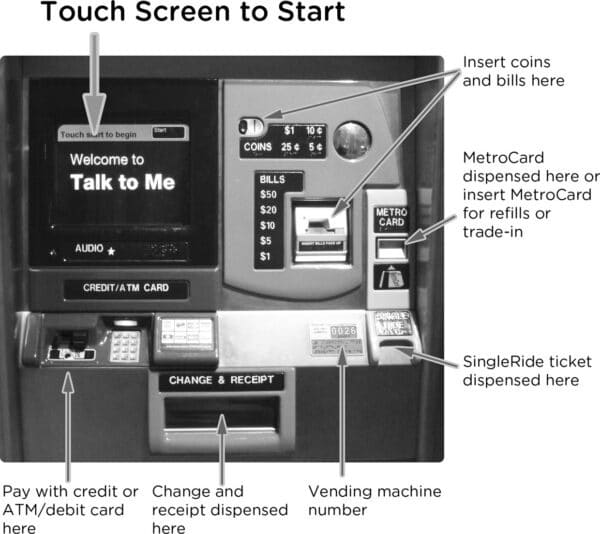
Touch the vending machine screen to start.
Then:
- Start
- Choose your language
- MetroCard
- Get New Card
- Pay-Per-Ride or 7-Day Unlimited Ride
- Select payment method
- Cash, ATM card or Credit
- Your card will come out from the slot labeled MetroCard.
Subway track work is often done on weekends or late at night so be prepared to find alternative routes to your destination during these times. Check the MTA website at www.mta.info for detailed fare information and service updates.
Free Events and Attractions in New York City
Big Apple Greeter: Visit NYC neighborhoods with a friendly volunteer who loves the Big Apple. Free community service offers a glimpse of a “New Yorker’s New York” on foot and by subway. 10-days advance notice requested.
Find out who’s buried in Grant’s Tomb National Monument and see exhibitions focusing on the Civil War and the life of General Ulysses S. Grant.
West 122nd Street and Riverside Drive
1.212.666.1640
Watch millions of dollars trade hands at the hustling, bustling New York Stock Exchange during work hours (nowadays you can’t get inside the NYSE due to security reasons but you can take pictures outside)
See the world’s largest Gothic Cathedral, St. John the Divine, near Columbia University and explore its Biblical Garden and Children’s Sculpture Garden.
112th Street and Amsterdam Avenue
1.212.316.7540
Enjoy the High Line with beautiful views of the city and urban garden spaces.
Take advantage of free or “pay what you wish” nights at the city’s finest museums, including:
Solomon R. Guggenheim Museum
Saturdays: 5:45 p.m. – 7:45 p.m.
89th Street and Fifth Avenue
1.212.423.3500
www.guggenheim.org
Museum of American Folk Art
2 Lincoln Square, Manhattan, NY 10023
212.595.9533
www.folkartmuseum.org
Free Admission
Cooper-Hewitt National Museum of Design
Tuesdays 5:00 p.m.- 9:00 p.m. (Check hours online.)
91st Street (between Madison and Fifth Avenues)
212.849.8400
www.cooperhewitt.org
Check prices online.
Museum of Modern Art
Fridays 4:00 p.m.- 8:00 p.m.
11 West 53rd Street and 5th Avenue
1.212.708.9400
www.moma.org
Explore thought-provoking exhibits at the breathtaking New York Public Library.
42nd Street and Fifth Avenue
917.275.6975
www.nypl.org
Enjoy free concerts, outdoor movies and other special events at Bryant Park.
42nd Street and Sixth Avenue (behind the New York Public Library)
1.212.768.4242
www.bryantpark.org
The Staten Island Ferry provides spectacular views of the Statue of Liberty and Lower Manhattan for free! Take the 1 train to South Ferry.
www.siferry.com
Free
Take a self-guided tour of majestic Rockefeller Center (free, pick up maps in the main lobby). You can also enjoy the summer gardens or ice-skating in winter.
30 Rockefeller Center
1.212.632.3975
www.rockefellercenter.com
Register online in advance to attend free tapings of popular TV shows
Stephen Colbert
1697 Broadway
www.cbs.com/latenight/lateshow
11th Ave. between 51st and 52nd St
Travel down Mulberry Street and enjoy the outdoor Italian restaurants and cafes of New York’s very own Little Italy. Take the 4, 5, or 6 train to Canal Street and walk north to Mulberry Street.
Take a walk in Chinatown, and explore the thriving district of exotic shops and restaurants along Canal and Mott Streets.
Head uptown toward Union Square. You will find some interesting architecture including the famous triangular Flatiron Building at 23rd Street (between 5th Avenue and Broadway). You can also stop by Union Square Park to rest, watch the local skateboarders or shop at one of the city’s largest outdoor farmer’s markets.
Attractions Under $20 in New York City
Enjoy a panoramic view of New York from the Observation Deck at the Empire State Building. Check website for ticket prices or stop by the InterExchange office during business hours to purchase your ticket at a special discount rate.
8:00 a.m.-2:00 a.m.
34th Street and Fifth Avenue
1.212.736.3100
www.esbnyc.com
For another breathtaking view of the city, head to the Top of the Rock in the Rockefeller Center.
www.topoftherocknyc.com
Check website for ticket prices.
Watch millions of years of the earth’s existence unfold at the American Museum of Natural History, including the world’s most exciting, extensive dinosaur halls. This is a donation-based museum.
79th Street and Central Park West
1.212.769.5100
www.amnh.org
Bask in the serenity of the medieval Cloisters (a branch of the Metropolitan Museum of Art) at Fort Tryon Park in upper Manhattan.
1.212.923.3700
www.metmuseum.org
Check website for ticket prices.
Explore the mysteries of ancient Egypt at the Brooklyn Museum’s world-class collection of Egyptian art and artifacts. Free entrance and parties the first Saturday of every month. Donation-based on other days.
200 Eastern Parkway, Brooklyn, New York
1.718.638.5000
www.brooklynmuseum.org
American Museum of the Moving Image. Ongoing exhibits on art, history and technology of film, TV and digital media. Closed on Tuesdays.
35th Avenue at 36th Street, Astoria, Queens
718.777.6888
www.movingimage.us
MOMA. Explore beautiful galleries full of modern art and sculpture.
10:30 a.m. – 5:30 p.m.
11 West 53rd Street and 5th Avenue
1.212.708.9400
www.moma.org
Check website for ticket prices. Free on Fridays from 4:00 p.m. – 8:00 p.m.
Roam endless galleries showcasing the world’s most extraordinary art at the Metropolitan Museum of Art. Pass can be applied to visit the Cloisters on the same day. This is a donation-based museum.
Sun – Thurs: 9:30 a.m. – 5:30 p.m. Fri-Sat: 10:00 a.m.-9:00 p.m. Closed on Mondays.
1000 5th Avenue at 82nd Street
1.212.535.7710
www.metmuseum.org
Suggested donation
See history in the making on guided, multilingual tours of the United Nations. All tours start in the UN North Lawn Building located at 47th Street and 1st Avenue. Tickets for tours are only available online and must be purchased in advance in order to enter the premise.
Mon-Fri: 9:30 a.m. – 4:15 p.m.
First Avenue between 42nd and 48th Streets
212.963.4475
www.un.org
Check website for ticket prices.
Put on a special headset for the world’s most advanced 3-D movies, shown on a screen more than eight stories high at the Sony IMAX Theater.
68th Street and Broadway
888.262.4386
Take a ride on the world-famous Staten Island Ferry, and includes spectacular views of New York Harbor and lower Manhattan. The ferry is free.
718.876.8441
www.siferry.com
Free
Catch the subway to the New York Transit Museum, set in a scenic 1930s station, where you can learn the history of the city’s famous public transportation system.
Boerum Place and Schermerhorn Street, Brooklyn
718.694.1600
www.nytransitmuseum.org
Check website for ticket prices.
New York Transit Museum/Gallery Annex (free)
Grand Central Terminal
42nd and Lexington Avenue
212.878.0106
GRAND CENTRAL GALLERY & STORE
Free
Learn about America’s “melting pot” heritage at the Statue of Liberty/Ellis Island Immigration Museum.
212.561.4588
www.statueofliberty.org
www.statuecruises.com
Check website for ticket prices
Chess players can visit Washington Square Park and sit with some of the greatest players in the world — for a small fee, of course. It’s not a bet, so if you win, don’t expect to get your money back (don’t pay more than $3. and don’t even think about gambling).
West 4th Street in the Village
Circle Line Sightseeing Cruises
Spend part of your day taking a boat tour of the Statue of Liberty, Ellis Island, the United Nations, the Brooklyn Bridge and more. Choose from 1-hour, 2-hour and 3-hour tours leaving from pier 16 at the South Street Seaport or pier 83 at 42nd Street.
212.563.3200
www.circleline.com
Check website for ticket prices.
See the city like the locals do on two scenic city MTA bus rides: the M5 from Greenwich Village to Riverside Drive, passing Chelsea, Rockefeller Center, Lincoln Center and Central Park South; and the M4 from Madison Avenue through Harlem to the Cloisters.
https://new.mta.info/schedules/bus
Check website for ticket prices.
Enjoy some ice-skating at the Rockefeller Center Ice Rink, located between 47th and 50th Streets and 5th and 6th Avenues.
1.212.332.7654
www.therinkatrockcenter.com
Check website for admission and skate rental prices.
Live Theater: Visit the TKTS booth in Times Square to get same-day tickets to Broadway or Off-Broadway musicals and plays for up to 50% off regular prices. You can also ask about standing-room-only tickets, which may be less expensive.
www.tdf.org
Street Fairs: From May through October, experience this cultural phenomenon of NYC. Get designer clothes on the cheap, eat some delicious Mozzerepas, and get a massage all on the same block! Various locations. Weekends. Look in Time Out New York magazine for weekly listings.
Rent a rowboat for a scenic paddle around the lake in Central Park in the shadow of Manhattan’s magnificent skyscrapers. You can also enjoy ice skating during the winter!
Loeb Boathouse, East side 74th Street to 75th Street
1.212.517.2233
www.thecentralparkboathouse.com
$15 an hour (cash only)
Experience wildlife attractions
Please visit the attraction’s website or call to confirm the admission price.
Bronx Zoo
64th Street and Fifth Avenue 2300 Southern Boulevard in the Bronx
bronxzoo.com/
$22.95 adults, general admission is free all day on Wednesdays.
Central Park Zoo
64th St and 5th Ave, New York, NY 10021
centralparkzoo.com
$18 adults
Prospect Park Zoo
450 Flatbush Avenue, Brooklyn, New York 11225
prospectparkzoo.com/
$8 adults
New York Aquarium
602 Surf Ave, Brooklyn, NY 11224
nyaquarium.com/
$11.95 adults
Nightlife in New York City
You’ll need lots of energy for a night out in The Big Apple, so start out by eating in Chinatown, Little Italy, the Lower East Side, Times Square or any other area of town that suits your fancy!
If you like rock music, head downtown to Alphabet City’s Mercury Lounge and catch some local bands or maybe world-famous rock musicians.
217 East Houston Street (between Ludlow and Avenue A)
1.212.260.4700
www.mercuryloungenyc.com
For a more mellow start to your evening, you might want to play billiards at Slate Restaurant and Billiards — you may even bump into a celebrity or two.
54 West 21st Street (between 5th and 6th Avenues)
1.212.989.0096
www.slate-ny.com
Relax with live jazz at the famous Blue Note in the Village.
131 West 3rd Street between 6th Avenue and MacDougal Street
1.212.475.8592
www.bluenote.net
In Times Square, go to Iridium, an eclectic restaurant/bar with some inspiring live jazz performances.
1650 Broadway and 51st Street
1.212.582.2121
www.iridiumjazzclub.com
Show off your talent at salsa dancing (or just fake it) at S.O.B.’s (Sounds of Brazil).
204 Varick Street
1.212.243.4940
www.sobs.com
Enjoy a drink and some Kielbasa at the traditional Bohemian Beer Garden, one of many located throughout all five boroughs. Since 1910, the Bohemian Hall and Beer Garden has been a part of New York history. Be careful, the good spirits and friendly atmosphere make it hard to leave!
29-19 24th Avenue. Astoria, Queens
www.bohemianhall.com
Brooklyn has become known for its cutting edge music scene, and you can hear the latest local bands (and some famous international ones too) at The Knitting Factory, Pete’s Candy Store or the Brooklyn Bowl.
The Knitting Factory
361 Metropolitan Ave.
1.347.529.6696
bk.knittingfactory.com
Pete’s Candy Store
709 Lorimer St.
1.718.302.3770
www.petescandystore.com
Brooklyn Bowl
61 Wythe Avenue
1.718.963.3369
www.brooklynbowl.com
If you still have the energy, Webster Hall is the place for you. You’re guaranteed a good time at this four-story disco theme park where you can dance to ’70s music, reggae, hip-hop, techno, rock or jazz.
125 East 11th Street
1.212.353.1600
www.websterhall.com
New York City Internet & Library Access
While in New York, you may want to e-mail your family and friends back home. Most public libraries offer free Internet access. In the past 5 years, New York City has installed internet access hubs branded LinkNYC. You can find a map of LinkNYC locations here. Remember to be cautious when using public or shared internet connections, and avoid logging into your bank unless you have taken appropriate security measures.
Your hostel or hotel may also have wi-fi a computer with Internet access. There are also many Internet Cafés. While at your job site, there may also be public libraries and/or Internet cafés in your host community. Many public areas also offer free wi-fi: Starbucks cafes, coffee shops, shopping malls and plazas.
New York Public Libraries
You do not need to be a member of the library or have a membership card. Usually, there is a sign-up sheet at a desk near the computers if you’d like to use them to access the Internet. Often, the wait is about 30 minutes, and you can use the computer for 30 minutes at a time. Check www.NYPL.org for your nearest location.
Stay in Touch!
Make sure to stay in touch with InterExchange when you travel, checking in to the online SEVIS system as required by your program.
Enjoy your visit to the United States and make the most of your cultural exchange experience by exploring all the opportunities to learn about the USA!
We love hearing about the places you visit and what you enjoyed most during your program. Share your experiences with us through our social media channels by making recommendations and posting photos of your favorite cities and sites!

